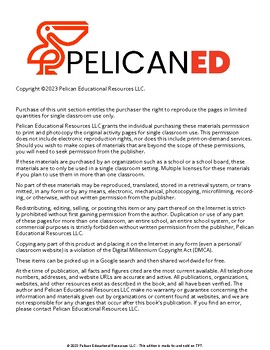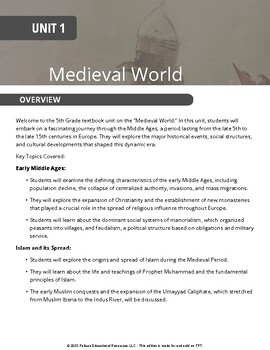Framework Companion: Medieval Europe | NEW STANDARDS |
Description
The Middle Ages, also called the Medieval Period, took place in Europe from about the end of the 5th century to the end of the 15th century. The early Middle Ages were marked by a drop in population, the fall of organized power, wars, and large-scale movements. As Christianity and other new religions spread across Europe, people started new churches. During this time, manorialism and feudalism ruled European society. Manorialism meant that peasants lived in villages that owed rent and labor services to nobles. Feudalism was a political system in which knights and lower-status nobles fought for their lords in exchange for the right to collect rent from lands and manors.
Lessons are focused on the course framework and have students analyze excerpts from a wide range of primary and secondary source documents. Then, the students answer the different supporting questions that help them answer the framing question. Students will complete various graphic organizers and question banks that will help them answer the framing questions. There are also a wide variety of readings that allow students to gain the core background knowledge needed to understand social studies. These activities have students working with primary and secondary sources, and they are specifically designed and chunked for better student comprehension, engagement, and fun!
Lessons are developed using all the sources and readings that are in the social studies course frameworks provided by the Louisiana Department of Education.
What do the Framework Companions include?
- Detailed lesson plans aligned with the standards and frameworks
- Activities that include all the materials provided in the frameworks
- Lesson activity workbook/worksheets
- Slide deck
Stanards
- 5.1 Create and use a chronological sequence of related events to compare developments and describe instances of change and continuity.
- 5.2 Use a variety of primary and secondary sources to:
- Analyze social studies content.
- Explain claims and evidence.
- Compare and contrast multiple sources.
- 5.3 Explain connections between ideas, events, and developments in world history.
- 5.4 Compare and contrast events and developments in world history.
- 5.5 Construct and express claims that are supported with relevant evidence from primary and/or secondary sources, content knowledge, and clear reasoning in order to:
- Demonstrate an understanding of social studies content.
- Compare and contrast content and viewpoints.
- Explain causes and effects.
- Describe counterclaims.
- 5.6 Create and use geographic representations to locate and describe places and geographic characteristics, including hemispheres; landforms such as continents, oceans, rivers, mountains, and deserts; cardinal and intermediate directions; climate and environment.
- 5.7 Use geographic representations and historical information to explain how physical geography influenced the development of civilizations and empires.
- 5.8 Describe the origin and spread of major world religions as they developed throughout history.
- 5.9 Describe the geographic, political, economic, and cultural structures of Europe during the Middle Ages.
- Identify and locate geographic features of Europe, including the Alps, Atlantic Ocean, Northern European Plain, English Channel, Ural Mountains, and the Mediterranean Sea.
- Describe the role of monasteries in the preservation of knowledge and the spread of the Catholic Church throughout Europe.
- Explain how Charlemagne shaped and defined Medieval Europe, including the creation of the Holy Roman Empire, and the establishment of Christianity as the religion of the Empire.
- Describe the development of Feudalism and Manorialism and their role in
Framing Question
What was life like in Europe during the Medieval Period?
Supporting Questions
- What changes led to the decline of the Western Roman Empire?
- How did the Middle or “Dark Ages” get its name, and what problems arose in Western Europe after the decline of Rome?
- What new ideas helped people in Europe during the Middle Ages?
- Why did King Charles earn the title Charles the Great or Charlemagne?
- How did the feudal system hold people, communities and kingdoms together?
- Why were castles important in the Middle Ages?
- How were the lives of Knights and Serfs similar and different?
- How was life in a medieval city different from life on a manor estate?
- What was it like to be a woman in the Middle Ages?




